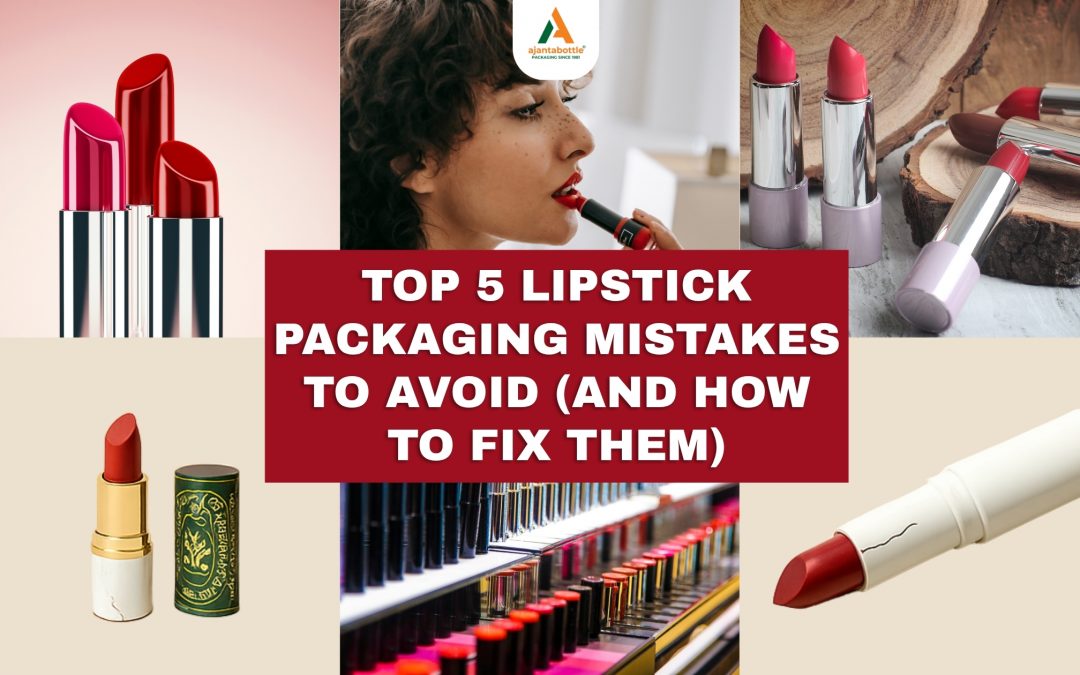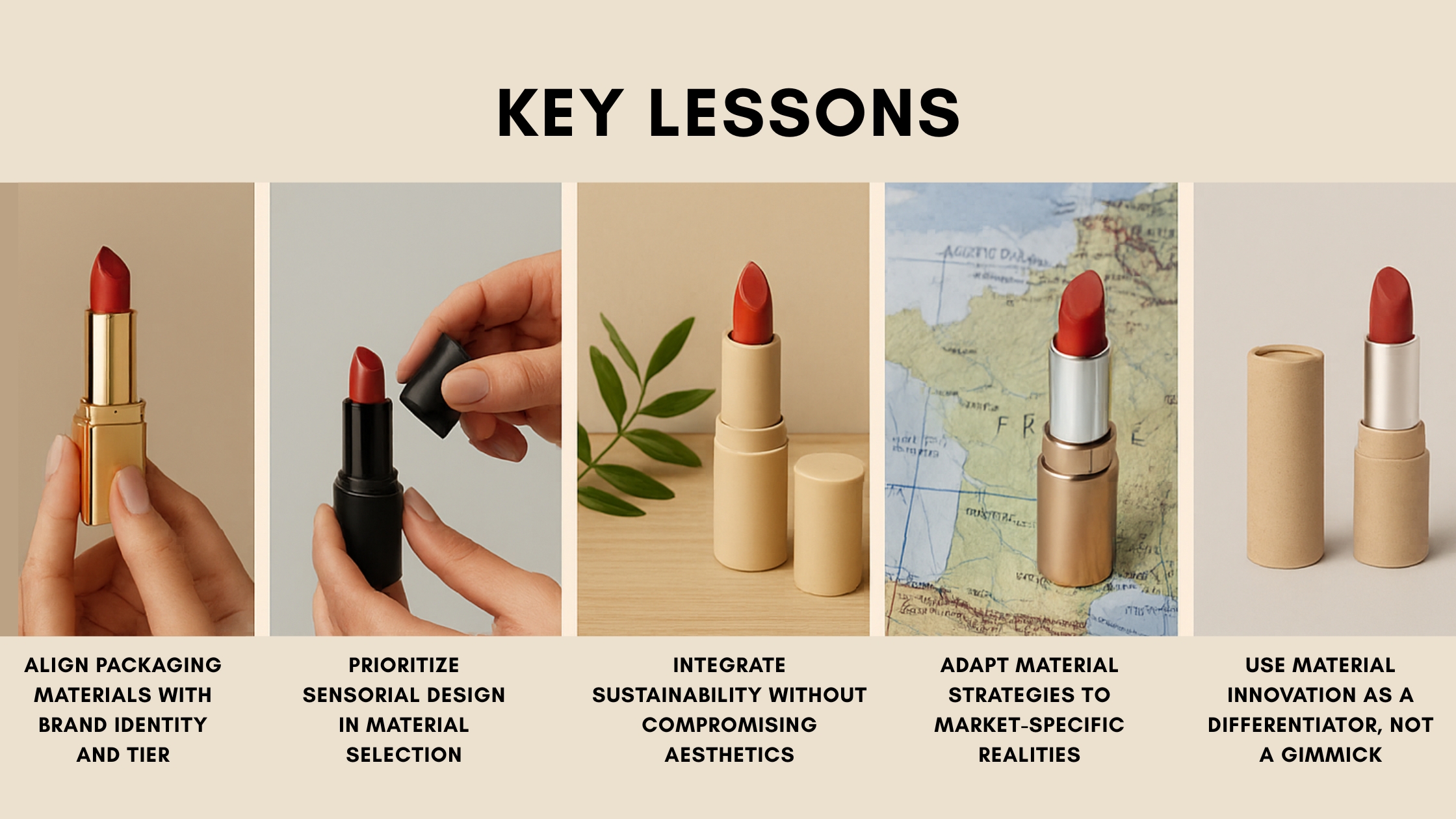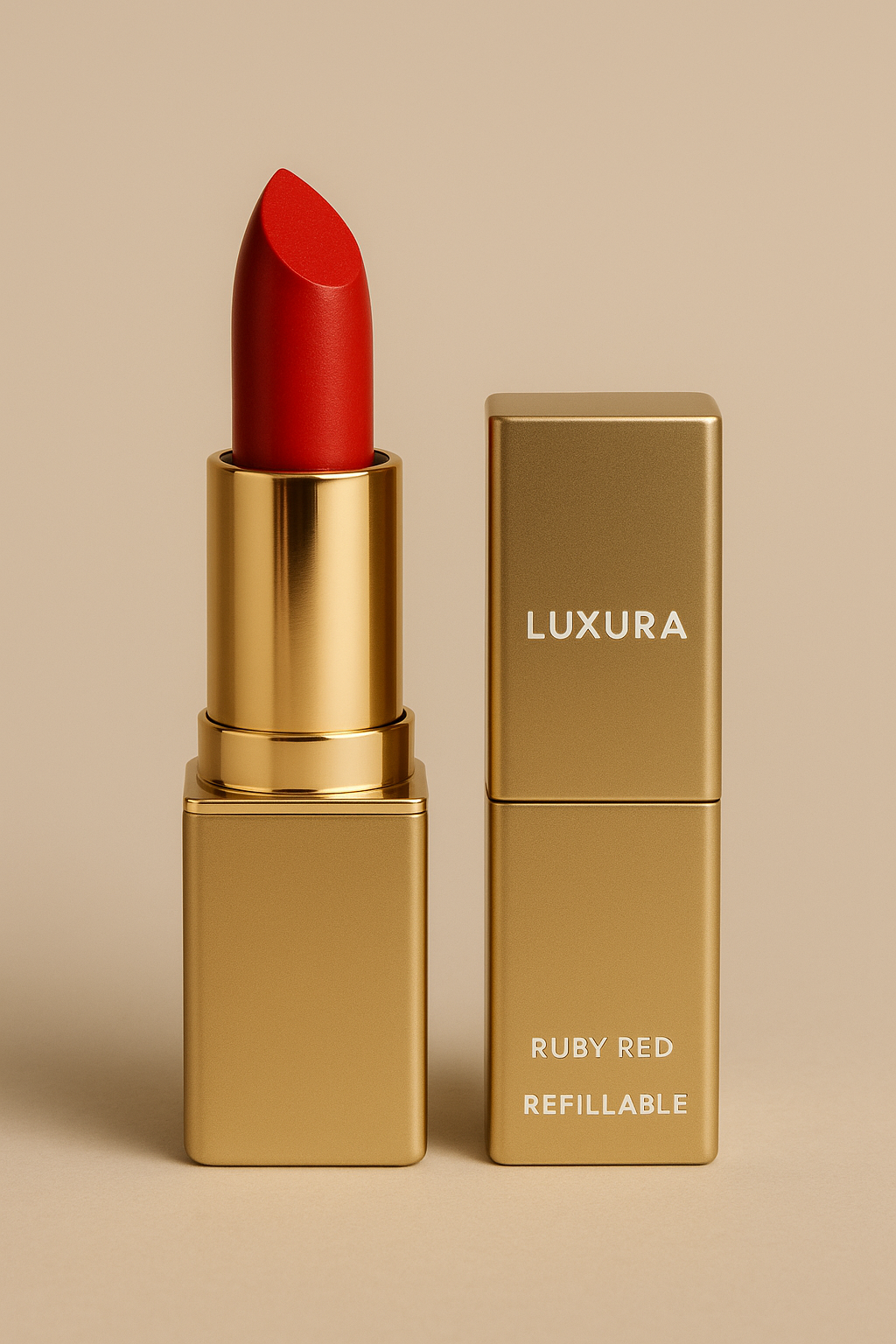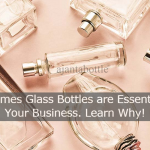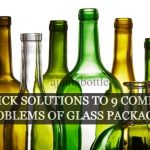Packaging isn’t the end of the product. It is the beginning of the experience.
Take a moment to picture a lipstick. Not the color. Not even the finish. But the first thing you touch. The case. The twist. The satisfying click of the cap. That singular moment defines everything that follows. This isn’t just lipstick packaging. This is your brand’s first impression.
In today’s beauty marketplace, this impression carries unprecedented weight. The global lipstick industry has grown to an estimated value of 14.2 billion dollars in 2024 according to Statista. Consumers are no longer simply buying a cosmetic product. They are buying a promise. A story. A piece of their identity. And the very first physical interface with that story is the packaging that holds your lipstick.
Yet so many brands continue to overlook this critical touchpoint. They invest time, money, and passion in the formula. They obsess over color payoff, staying power, and vegan certifications. But when it comes to the lipstick’s container, they settle. And this quiet compromise can sabotage an otherwise brilliant product.
If your lipstick tube cracks after a week. If the cap does not click firmly. If the packaging feels cheap in the hand. Then none of your innovation matters. The consumer has already made up their mind. They will not return.
This article is for the brands that want to get it right. For founders, designers, and marketers who want to understand what lipstick packaging must do in 2025 and beyond. It is not enough to be good. It must be unforgettable.
Let us dive deep into the five most damaging lipstick packaging mistakes seen across the industry today. And let us explore what to do instead if your goal is to build trust, beauty, and longevity.
The Emotional Weight of Lipstick Packaging
Before we begin unpacking the mistakes, it is essential to understand why lipstick packaging matters so much in the first place. Lipstick is a ritual. It is confidence in a twist. It is carried in clutches, left on vanities, and reached for during life’s most personal moments. Unlike foundation or serum, lipstick travels. It is touched, opened, applied, and admired repeatedly. It is packaging that must endure scrutiny.

In a recent study by Mintel, 68 percent of women stated that they consider lipstick packaging to be a reflection of brand credibility. This number jumps to 74 percent among Gen Z beauty buyers. Consumers may not always verbalize it, but they do judge a lipstick by its cover.
The packaging sets expectations. It tells a visual story. It offers tactile assurance. When done well, it becomes part of the product experience. When done poorly, it becomes a reason for rejection.
Now let us explore what not to do.
Mistake One: Compromising on Packaging Material
This is the most frequent and the most fatal of all lipstick packaging missteps. A brand claims to offer a premium product, but houses it in a brittle, squeaky plastic tube that cracks under daily use. The disappointment is instant. The damage is permanent.
The Consumer Perspective
Recent studies highlight a significant shift in consumer behavior:
-
70% of beauty consumers associate product quality with the sturdiness and finish of the packaging.
-
Social media platforms amplify consumer experiences, making packaging flaws highly visible and potentially viral.
This data underscores the importance of selecting materials that not only protect the product but also enhance the user experience and brand perception.
Material Innovations and Trends
The beauty industry in 2025 is witnessing a surge in innovative materials that balance aesthetics, functionality, and sustainability:
-
High-Performance Plastics: Materials like PET-G and PP offer durability and design flexibility, making them popular choices for brands aiming for a modern look without compromising on strength.
-
Metallic Finishes: Brushed aluminum and anodized metals are favored for their premium feel and recyclability, aligning with luxury brand images.
-
Biodegradable Options: Bioplastics derived from renewable sources are gaining traction, catering to eco-conscious consumers.
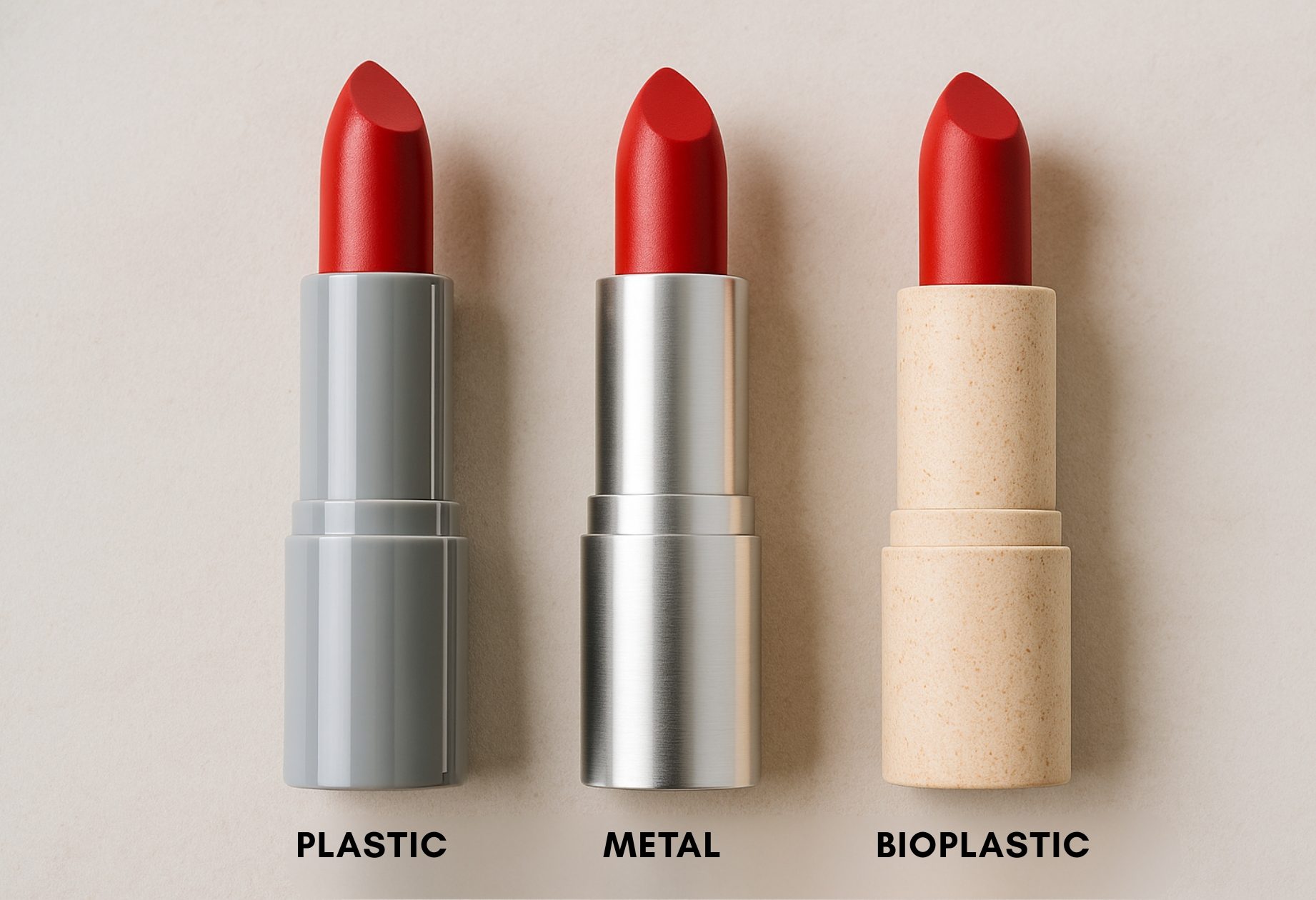
Several brands have successfully embraced these material trends:
Hermès Beauty has set a gold standard in luxury lipstick packaging by embracing lacquered metal cases that are both tactilely elegant and functionally superior. Their 2025 Spring collection features refillable bullets that click into place magnetically. These lipsticks retail at a premium, but consumers are buying into the experience—owning a lipstick that feels like jewelry. What sets Hermès apart is the use of anodized aluminium, which resists corrosion and adds weight, reinforcing the product’s luxurious perception. The refill mechanism not only supports sustainability but also draws in the high-end, eco-conscious buyer. Their refillable model has also allowed them to grow revenue through cartridge sales, creating a new recurring purchase stream.
Ami Colé, a rising star in the clean beauty space for melanin-rich skin tones, released their Lip Treatment Oil in a soft-touch PET tube with a molded, contoured applicator in late 2024. While not a traditional lipstick, this product was praised for its minimalist, travel-friendly design and material choice that combines sustainability and tactile satisfaction. Their soft-touch PET used a 30% post-consumer resin (PCR) blend, appealing to conscious consumers without sacrificing form. The brand’s subtle matte finish and transparent cap delivered a clean aesthetic that directly communicated purity and functionality, resonating with their ethical beauty narrative.
In 2025, Rose Inc pushed the boundaries with their new Compost & Click lipstick line. These lipsticks are packaged in partially compostable bioplastic outer shells made from corn-based PLA, combined with a snap-fit inner refill cartridge. The refill module is made from durable PP, which is easier to recycle in global waste systems. What makes this packaging unique is the home-compost-certified PLA cap, which disintegrates under composting conditions within 90 days. The product won Packaging Innovation of the Year at the 2025 Beauty Awards and has been widely embraced by zero-waste beauty communities.
Charlotte Tilbury, known for its rose-gold lipstick cases, the brand combines aesthetic appeal with sturdy construction, enhancing the overall product experience.
Key Lessons from These Brands
These real-world examples showcase that lipstick packaging success hinges on:
The following lessons are crucial for brands aiming to deliver packaging that is functionally robust and emotionally resonant.
1. Align Packaging Materials with Brand Identity and Tier
The tactile, visual, and structural qualities of packaging must consistently reflect the brand’s core positioning. Premium or aspirational brands benefit from weightier, more durable materials that communicate elegance and permanence, while contemporary or minimalist brands may opt for clean, sleek, and lighter formats. The congruence between packaging and brand language must be deliberate, not incidental.
2. Prioritize Sensorial Design in Material Selection
Material decisions should consider not only physical resilience but also the emotional cues they convey through weight, surface texture, closure sound, and hand-feel. These sensory signals are now being engineered with precision to heighten perceived product value. When thoughtfully executed, they can significantly enhance unboxing experiences, instill consumer confidence, and drive product retention.
3. Integrate Sustainability Without Compromising Aesthetics
Eco-conscious packaging is no longer a secondary feature but a baseline expectation. However, sustainability should be designed to complement aesthetics, not hinder them. With advancements in bioplastics, refillable systems, and recyclable alloys, it is possible to meet environmental targets while delivering distinctive visual and tactile quality. Integration should be seamless, not performative.
4. Adapt Material Strategies to Market-Specific Realities
Packaging decisions must account for regional climates, cultural preferences, and user behavior. Materials must perform consistently in varying humidity, heat, and handling conditions while aligning with local consumer expectations. Brands must localize packaging design not only in language or artwork, but in structure and material tolerance as well.
5. Use Material Innovation as a Differentiator, Not a Gimmick
Innovative materials should serve clear functional or experiential benefits—not novelty alone. Whether the goal is reusability, personalization, compostability, or visual storytelling, innovation must deepen consumer trust and elevate product engagement. Material excellence, when linked to real brand purpose, can build long-term loyalty and industry recognition.
Mistake Two: Overlooking Sustainability
Sustainability is not a side note anymore. It is a decision-making priority. If your lipstick packaging cannot be recycled, refilled, or reused, you are already behind.
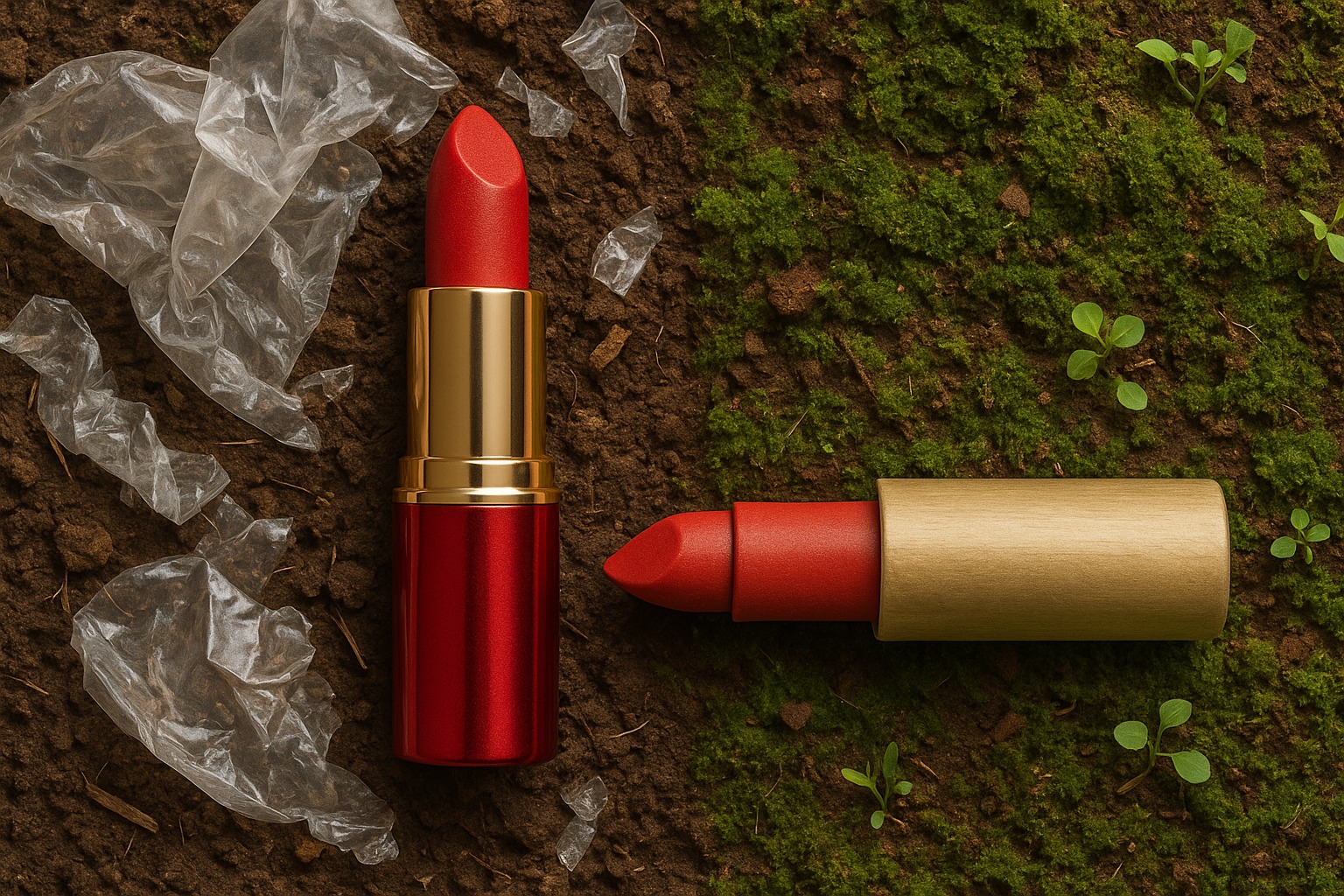
According to NielsenIQ, 60 percent of global beauty consumers are willing to pay more for sustainably packaged products. Refillable lipstick packaging is one of the fastest growing segments, predicted to hit 1.3 billion dollars in global market value by 2025 according to Euromonitor.
Yet many brands still use multilayered plastic that cannot be separated or processed. Others use sustainable materials but fail to communicate it on the pack. In either case, it is a missed opportunity.
Here is how to improve.
Shift toward bioplastics like PLA or sugarcane polymers. Explore paperboard-based exterior sleeves or metal tubes with refillable cartridges. Make the sustainability claim visible. State clearly whether the tube is recyclable, biodegradable, or refillable. If you have a take-back program, print that too.
In May 2024, Huda Beauty launched its first refillable lipstick with magnetic inserts and polished aluminium housing. Their marketing focused heavily on the dual promise of luxury and conscience. The result was a 30 percent increase in sales within the launch quarter.
Consumers today want lipstick packaging that mirrors their values. When you align with their mindset, they reward you.
Mistake Three: Overcomplicating the Design and Undermining Clarity
In the fierce race to stand out on shelves and screens, many lipstick brands fall into a common trap—they try to say too much, show too much, and do too much on the packaging. The result is visual noise. What was meant to look artistic ends up looking confused. What was meant to feel luxurious feels overwhelming.
In 2025, when consumers are bombarded by visuals across retail and e-commerce alike, the ability to communicate clearly and confidently through packaging design is a mark of modern brand intelligence. Simplicity does not mean plainness. It means strategic clarity. It means having the discipline to say what matters and eliminate the rest.
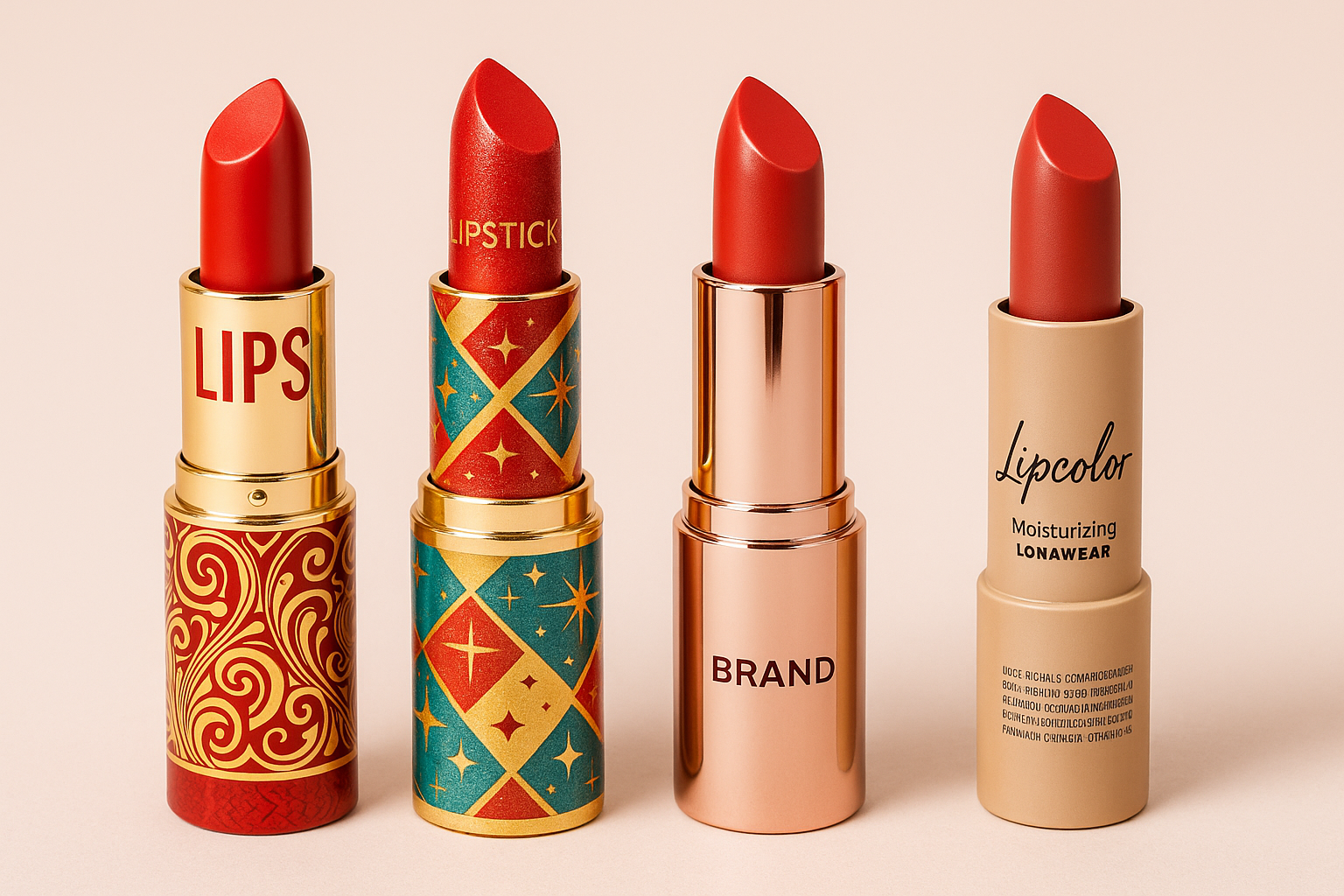
Understanding the Consumer’s Visual Threshold
According to Mintel’s Global Packaging Trends Report 2024, minimalist packaging in the beauty segment performed 27 percent better in shelf-level conversion than ornate packaging. The same report noted that over 60 percent of beauty consumers associate clean design with trust and product efficacy.
Why? Because visual clutter requires cognitive effort. In high-density retail environments or fast-scroll e-commerce, consumers make snap judgments. A lipstick tube with crowded typefaces, excessive metallic foils, and layered visual motifs triggers decision fatigue. On the other hand, a streamlined, elegant design offers clarity—and clarity signals confidence.
Common Overdesign Pitfalls
Here are the five most common symptoms of overdesigned lipstick packaging:
- Multiple typefaces competing for attention with no visual hierarchy
- Clashing colors or gradients that confuse rather than attract
- Too much text on limited real estate—ingredient callouts, dual-language content, claims, certifications—all squeezed together
- Irregular shapes or closures that may feel novel but reduce usability
- Decorative elements like foil stamping, embossing, holographic inks, and patterns—used all at once, instead of purposefully
The Psychology of Simplicity
Minimalist packaging is not about aesthetic preference alone—it speaks to consumer psychology. Clean designs communicate efficacy, purity, and transparency. In a digital-first world, minimalist packaging also photographs better, leading to increased user-generated content on platforms like Instagram, Pinterest, and TikTok.
Minimalism also bridges trust across demographics. Gen Z appreciates its sleekness. Millennials perceive it as premium. Boomers associate it with ease of use and clarity. It is cross-generational in appeal.
Design Strategies That Work in 2025
Here’s how to execute effective, minimalist lipstick packaging design that cuts through the clutter without losing identity:
1. Master Visual Hierarchy
Establish a clear order of information. The brand logo should be the visual anchor, followed by essential info like shade name or finish. Supporting information (e.g., sustainability or refillability) should be placed subtly on secondary surfaces or communicated through color coding or symbols.
2. Choose a Typeface That Reflects Your Brand Voice
Limit yourself to one carefully selected font family. Whether it’s a timeless serif for a heritage brand or a clean sans-serif for a modern aesthetic, consistency in typography is one of the strongest brand cues.
3. Use Color with Intent
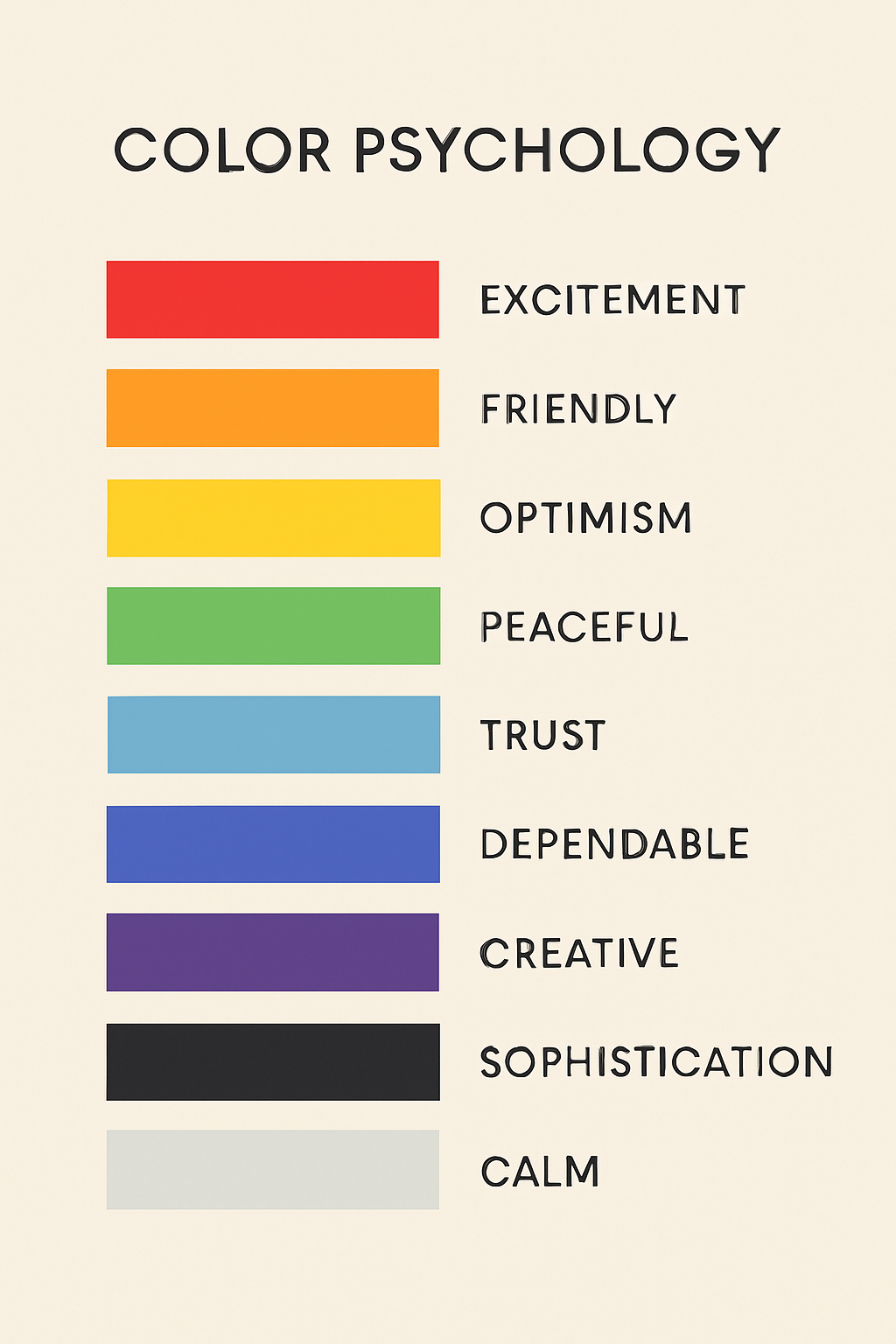
Every color evokes emotion. Use it wisely. In lipstick packaging:
-
Gold, burgundy, and black often connote sophistication and drama
-
Pastels and matte nudes suggest softness, purity, and a lifestyle focus
-
Bold single-color shells create instant shelf presence without noise
Color psychology should always align with the formulation’s emotional intent. Is this a power lipstick? A daily ritual balm? A nighttime indulgence?
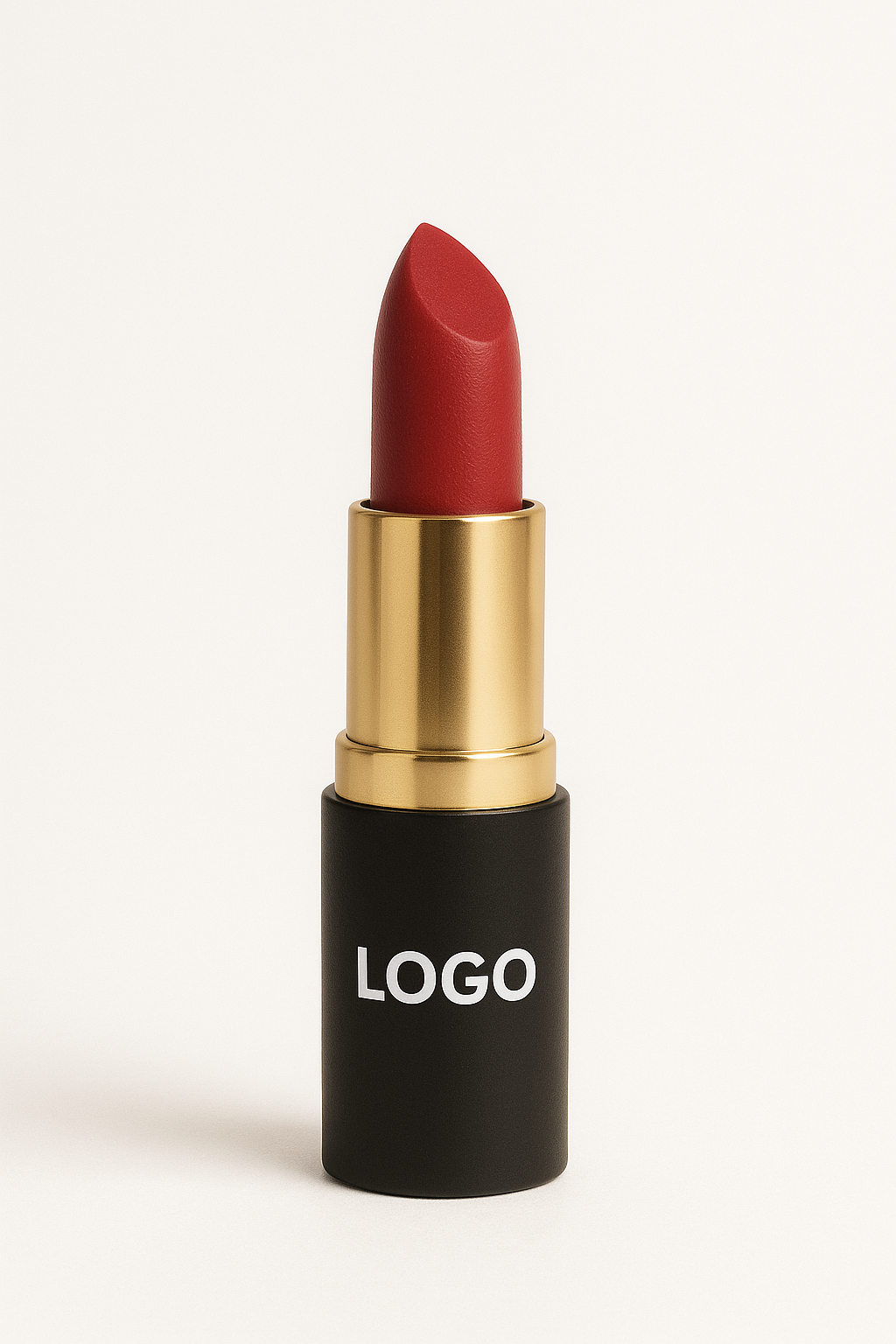
4. Let Whitespace Breathe
Whitespace isn’t empty—it’s active. It frames the design, gives prominence to the logo, and elevates the entire visual language. It is a quiet but powerful way of saying, “We are confident in our brand.”
5. Consider Structural Minimalism
The shape of your lipstick tube should feel intuitive, ergonomic, and iconic. Avoid overly complex closures that frustrate the user or require two hands to open. Packaging should enhance the ritual of application, not disrupt it.
6. Design for Digital Visibility
Packaging should photograph well in all light conditions. Avoid materials that overly reflect or distort under flash or ring lights. Think about how the tube looks in a flat lay, a hand swatch video, or a quick unboxing reel. In 2025, design decisions must be influencer-ready from day one.
The Business Case for Minimalism
Streamlined packaging design also yields supply chain advantages. Fewer materials, simpler printing processes, and reduced secondary decoration lower production costs and environmental impact. From a scalability standpoint, minimalist packaging is easier to adapt across SKUs, regional languages, or seasonal editions without reinventing the core design architecture.
Minimalism is not about saying less. It is about saying the right thing in the right way. In the world of lipstick, where competition is relentless and the consumer’s attention is fleeting, your packaging must speak instantly—and memorably.
Mistake Four: Ignoring Real-World Durability
Your lipstick may look beautiful in a mockup, but if it does not survive daily use, you have failed your consumer.
Beauty packaging today must meet real-world durability standards. The Statista Beauty Consumer Report 2024 revealed that 43 percent of consumers who switched brands did so because of poor packaging functionality.
Tubes that melt in heat. Caps that fall off in purses. Labels that fade within weeks. These are all silent killers of brand trust.
So what should your testing regimen look like?
Drop simulations from standard handbag height. Heat exposure tests up to 50 degrees Celsius. Resistance to pressure when sat upon or tossed. Seal integrity for leak-proof promise. Abrasion tests for brand name visibility.
RMS Beauty redesigned its lip balm in late 2023 after receiving complaints about cap looseness. Their 2024 model features a magnetic lock and a reinforced twist base. Consumers responded with praise and higher repurchase rates.
Your lipstick packaging should feel like a companion, not a concern.
Mistake Five: Ignoring User Experience – When Beauty Isn’t Functional
When it comes to lipstick packaging, too many brands focus only on visual appeal, forgetting that lipstick is not merely a product—it is a daily, tactile ritual. A lipstick’s packaging must do more than look beautiful. It must feel beautiful in action. From the first twist to the last swipe, every interaction becomes a subconscious dialogue between the user and your brand.
User experience—or UX—is not a design afterthought. It is the heartbeat of modern product strategy. And in 2025, it is increasingly the difference between a one-time curiosity and a lifelong customer.
Why UX Has Become a Make-or-Break Factor in Lipstick Packaging
According to Mintel’s 2024 Beauty Consumer Behavior Report, 39 percent of lipstick users are more likely to repurchase a product if the packaging feels comfortable, intuitive, and enjoyable to use. That’s nearly four out of ten customers making buying decisions not based on color or formula—but on packaging interaction alone.
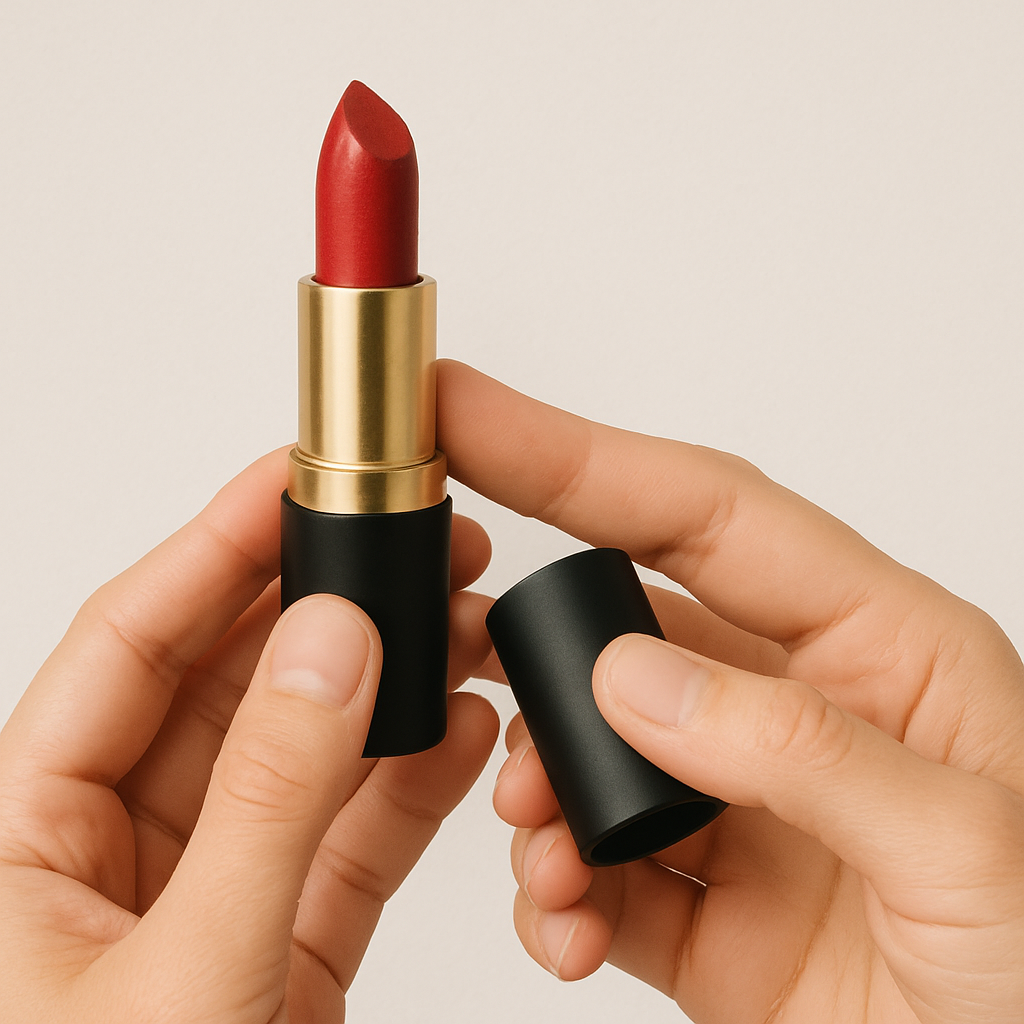
As beauty consumption becomes more emotional, experiential, and shareable, lipstick packaging that causes frustration—be it a stiff cap, a wobbly twist mechanism, or an awkward grip—can quickly erode customer goodwill. And unlike formulation issues that may take time to detect, UX failures are immediate. They are felt. They are remembered. And increasingly, they are shared online.
In a saturated lipstick market, UX is brand equity.
What Does Lipstick UX Actually Encompass?
User experience in lipstick packaging covers a wide spectrum of design elements. Each one plays a crucial role in how the customer connects with the product.
1. Grip and Ergonomics
The lipstick tube must feel stable and satisfying in the user’s hand. A slippery surface or an awkward contour can lead to fumbles, dropped products, and brand dissatisfaction.
-
Textured finishes and matte coatings can enhance grip.
-
Thumb grooves or flat-sided bodies help with stability during application.
-
Tube diameters between 1.4 and 1.8 cm are preferred for one-handed control.
2. Ease of Opening and Closing
Can the cap be opened with one hand while holding a phone or bag in the other? Does it make a satisfying click when closed? A poorly designed cap system is one of the most common complaints in consumer reviews.
-
Magnetic closures, push-click mechanisms, and smooth friction-fit caps add polish to UX.
-
Caps should close securely without excessive force.
-
Twist mechanisms should not feel loose, nor require repeated attempts.
3. Twist-Up Mechanism Sensitivity
Does the lipstick glide upward smoothly? Is it easy to control how much product is exposed? Mechanical failure here is a significant red flag.
-
Controlled resistance in the twist-up feels more premium.
-
Over-twisting should be prevented with stop-lock design features.
-
The twist mechanism should not rotate in the pocket or makeup bag accidentally.
4. Portability and Pocket-Friendliness
Lipsticks are mobile companions. They are stored in bags, pockets, pouches, and car consoles. Packaging that is too bulky, too fragile, or prone to opening on its own does not survive real life.
-
Tubes should be travel-proof—resistant to leaking, popping open, or melting.
-
Edges should be smooth to avoid snags in fabric.
-
Materials must withstand mild heat and moisture environments like handbags and glove compartments.
5. Tactile Feedback and Sensory Memory
The sensory “feel” of a lipstick application—the twist, the click, the finish—is deeply associated with product satisfaction.
-
A soft matte or velvet-like finish elevates the experience.
-
Audible closure cues like a clean “click” create emotional reinforcement of quality.
-
Weight distribution contributes to perceived value—the lipstick should neither feel too hollow nor unnecessarily heavy.
Why UX Is No Longer Optional
With the explosion of video-based platforms like TikTok, YouTube Shorts, and Instagram Reels, packaging performance is now under constant review. Influencers and everyday users demonstrate how easily a lipstick opens, how it twists, and how it feels. Your packaging’s usability is no longer a private matter—it is content.
The brands winning in this landscape are the ones that design lipstick packaging as a tool, not just a container. They understand that packaging is not packaging. It is part of the product experience. It is where love for a brand is often formed—or fractured.
Proactive Strategies to Optimize Lipstick UX
To improve the user experience of your lipstick packaging, implement the following best practices:
-
Conduct real-world usability testing before launch. Include diverse demographics—left-handed users, users with mobility limitations, and consumers across age groups.
-
Benchmark against your competitors. Collect consumer reviews and identify common UX issues in the category. Turn these into design opportunities.
-
Use UX metrics alongside aesthetic criteria when evaluating prototypes. Test for time-to-open, ease-of-use score, and grip comfort index.
-
Collaborate with industrial designers, not just graphic designers. The functional form matters as much as the visual message.
-
Iterate often. A single design flaw—like a cap that weakens over time—can erode consumer trust for the entire product line.
As manufacturers and brand builders, you know better than anyone that lipstick is not just a cosmetic—it’s an experience, a promise, and a symbol of identity. But even the most exceptional lipstick formulas can fall short if the packaging does not reflect the care, quality, and values you’ve poured into the product itself.
Packaging is not simply a case to hold lipstick. It is the first expression of your brand’s credibility. It is your handshake with the customer before a single word is spoken or a shade is swatched. When packaging cracks, confuses, or disappoints, it doesn’t just damage the product—it damages the brand. But when it delights, protects, and performs, it amplifies everything your lipstick stands for.
In today’s evolving landscape where consumers demand sustainability, seamless design, and reliability, packaging is no longer optional refinement. It is strategic necessity.
So as you develop your next lipstick line—whether it is for mass retail, luxury counters, or clean beauty niches—ask yourself:
-
Will this packaging enhance or erode the trust I’m trying to build?
-
Does it align with how my brand wants to be remembered?
-
Will it hold up in the real world, and in the hands of real people?
If even one of those answers isn’t a confident yes, it’s time to rethink.
Why Ajanta Bottle Is Your Trusted Partner in Lipstick Packaging – Let’s Build This Together
At Ajanta Bottle, we’ve spent over four decades mastering the art and science of packaging. From glass to aluminum to closures and now cosmetic formats, every step in our journey has been about understanding what brands truly need—and delivering it with precision.
Today, as we enter the world of lipstick packaging, we do so not just with enthusiasm, but with the backing of our legacy, our industry knowledge, and a commitment to raising the bar. We are currently sourcing and importing premium lipstick packaging components while building a long-term roadmap to expand our capabilities in this space. This is a new but promising segment for us, and we believe collaboration is key.
If you’re a beauty brand, a cosmetics manufacturer, or a product development expert, we invite you to work closely with us—to co-create, to innovate, and to refine lipstick packaging that meets the expectations of today’s dynamic market.
Let’s shape the future of lipstick packaging—together.
Connect with us:
● Email at sales@ajantabottle.com
● Phone/Whatsapp: +91 9891098918
You can also shop from more than 500+ packaging solutions on www.ajantabottle.com – India’s first ever comprehensive packaging e-commerce portal.
For additional information, browse through our blog at https://www.ajantabottle.com/blog/ or subscribe to our latest updates through our social media channels,
*YouTube channel: https://www.youtube.com/c/Ajantabottle
*LinkedIn Page: https://www.linkedin.com/company/ajantabottle
*Facebook Page: https://www.facebook.com/glassbottleindia
*Instagram Page: https://www.instagram.com/ajantabottle
*Google Business Profile Manager: https://g.page/r/CXTH9MKpe2DuEBM/review

